|
Low-Budget PDA Overview
By: Dave
- December 1st, 2002
Palm OS Based Palm
OS products have always covered the lower-end of the PDA market, but both
Palm and Sony have released products that are extremely affordable, even
to the cashless student. Palm came through with a sub-$100 device
while Sony as a series of products for users that want spend less
then $300. The simple style of the Palm OS along with the lower-end
technology make these devices inexpensive and economical solution for
users that was to carry data with them and keep track of data better.
| Palm's Zire packages Palm
OS functionality into a PDA that is under $100. The Zire is
based on a 16Mhz Dragonball processor with 2mb of memory. The
Zire isn't a power device but is made for simplicity and for getting
users interested in what a PDA can do for them. It utilizes a
simple grayscale screen and includes two buttons in a 3/5"
thick package. The device can display the portability of PDA's
but its only real functionality is for personal information
management (PIM). |
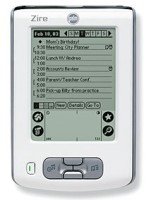
|
|

|
Sony's CLIE SJ20 simple
device that packs some special features. Based on a 33Mhz
Dragonball processor, the SJ20 includes 16mb of internal memory (the
same amount that many high-end Palm OS devices includes). It
also includes the standard Sony Memory Stick slot for
expansion. Though the SJ20 only has a grayscale screen, it has
twice the resolution of other devices meaning a better display
quality. |
| Sony's CLIE SJ30 is a
color version of the SJ20. It includes a 33Mhz Dragonball
processor as well as 16mb of memory. It includes a Memory
Stick slot as well as a high resolution screen. The screen
features 16-bit color for the extra $100. The SJ30 can
complete with other Palm OS 4 based devices and provides better
support for applications. |
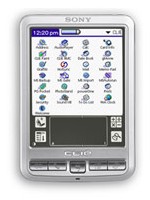
|
Low-Budget Palm OS Device
Comparison
(Selected Specifications)
| |
Palm Zire |
Sony SJ20 |
Sony SJ30 |
| Processor |
16Mhz |
33Mhz |
33Mhz |
| RAM |
2mb |
16mb |
16mb |
| Expansions |
None |
Memory Stick |
Memory Stick |
| Thickness |
0.6" |
0.66" |
0.66" |
| Display Colors |
Grayscale |
Grayscale |
16-bit Color |
| Price |
$99 |
$199 |
$299 |
Pocket PC Based Never before have so many Pocket PC's been released at an
initial price of under $300. For the most part, since the Pocket PC platform hit the market, it has been a high end PDA, but finally
manufactures have seen the light and decided to go head to head with Palm OS devices of a comparable price. In the past, low cost devices have always had a increased
bulk either because it was a measure to deflate costs or to promote upgrading to a more expensive device. But once again,
manufactures seem to have to come a realization. Pocket PC's should show their true colors in all form, inexpensive and expensive. That is just what the inexpensive devices from Dell, HP,
and Viewsonic do.
| Dell's Axim X5 (Advanced Version) provides top of the line power and
expandability into a low priced device. The Axim utilizes the Intel XScale
processor running at 400Mhz with 64mb of internal RAM and 48mb of ROM
(some of which can be written to by the user). Users have the ability to upgrade via a Compact Flash slot or the Secure Digital slot (which is
not SDIO compatible). The Axim
includes a 1440mAh removable lithium battery. A draw back to the Axim is its size. Though it is similar to the
form factor of an iPAQ (3000 series) or a Jornada (560 series), it isn't ultra-thin like many users might be looking for. |
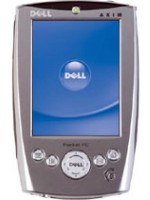
|
|
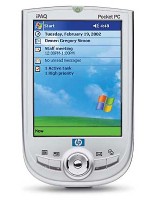
|
HP's iPAQ H1910 carries the iPAQ name but in a new
form factor. The new size and style doesn't allow the 1910 to utilize the previous iPAQ expansion sleeve system. The 1910
utilizes the Intel XScale processor running at 200Mhz with 64mb of internal RAM
(xxmb available to the user) and 16mb of ROM. Some of the internal RAM is used by extra software included with Pocket PC 2002 like Windows Media Player. Since the ROM is only 16mb, the 1910 suffers from the same problem users saw with the 3600 iPAQ upgrades, that being that all Pocket PC components cannot fit into the ROM. The 1910 includes a SD slot (not
SDIO) and a 900mAh lithium battery. |
|
ViewSonic's V35 is one of the
(if not the) smallest Pocket PC's ever. The V35 utilizes the Intel XScale processor running at 300Mhz with 64mb of internal RAM and 32mb of ROM. For
expandability, the V35 includes a Secure Digital slot (SDIO). The V35 uses a lithium battery. Not only is the V35 ultra-thin but also ultra-light.
ViewSonic bundles the V35 with a transflective screen (same as the
iPAQ 3900's), for a vibrant display in almost any light. |
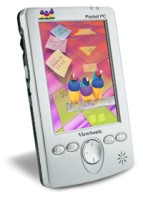
|
Low-Budget Pocket PC Comparison
(Selected Specifications)
| |
Dell Axim |
iPAQ 1910 |
V35 |
| Processor |
400Mhz |
200Mhz |
300Mhz |
| RAM/ROM |
64/48 |
64/16 |
64/32 |
| Expansions |
SD & CF |
SD |
SDIO |
| Thickness |
0.7" |
0.5" |
0.4" |
| Battery |
1440mAh* |
900mAh |
Unknown |
| Price |
$299** |
$299 |
$299 |
* Battery is removable
** After $50 manufacture rebate |
Making a Choice
Out of the six products,
each really has a different feel and style to it. Based on what you
need and what you like, one style product might better suit you. A
gift of any of these to someone that new to mobile computing would be well
received and allow the user to explore what PDA's have to offer, though I
would take a look and consider how the receiver is likely to use the
device. The
first thing to aid a decision is to look into which operating system is
right for you (or makes the most sense). Many users find that the Palm OS is a much better
operating system for organizer style use. Others look at the Pocket
PC as being more like their desktop computer. Each product has its
pros and cons, but certain devices will be better for certain types of
people. Users looking to go wireless might consider a Dell Axim as
it has the Compact Flash slot that can easily support various wireless
cards.
Users that want an inexpensive device to use as an organizer might look
toward the Palm Zire as it is simple and practical for that purpose. Users that want a go anywhere product with
room for growth might look to the Sony CLIE or ViewSonic V35 as each is a
solid product with built in expansion technology like the Memory Stick or
Secure Digital. Out of
these six products there really is something that can satisfy almost all
types of users. But the most important thing when choosing a devices
is which feels the best...so go out and try some!
|
If some of the
terminology used in the feature is unclear, here are some
definitions that may help. |
| CF
- Compact Flash. Likely the most widely used expansion
technology that is not only memory but various other types of
expansion as well
RAM - Random Access
Memory. The bulk of the data interacted with by the user is
stored here. Larger is usually better as it gives more space
to work with.
Mhz - Megahertz. Measure
of processor speed. Higher processor speed means the device
can do calculations (think) faster. |
SD -
Secure Digital. Similar to CF but a different form factor
(smaller). SD slots can only handle memory.
ROM - Read Only Memory.
Similar to RAM, but is primarily used for storage of the operating
system, various programs, and in some cases user data. |
SDIO -
Same as SD but can handle cards other then memory. (Currently,
this means only Bluetooth.)
mAh - Milliamp Hours.
The bigger the number the better. It all depends on the
device, but a bigger number often means longer battery life. |
|
Still unclear on
something? Email dave@davespda.com |
|

